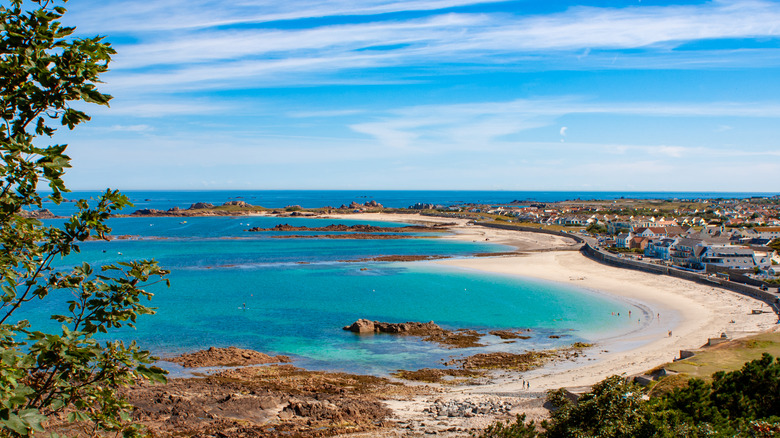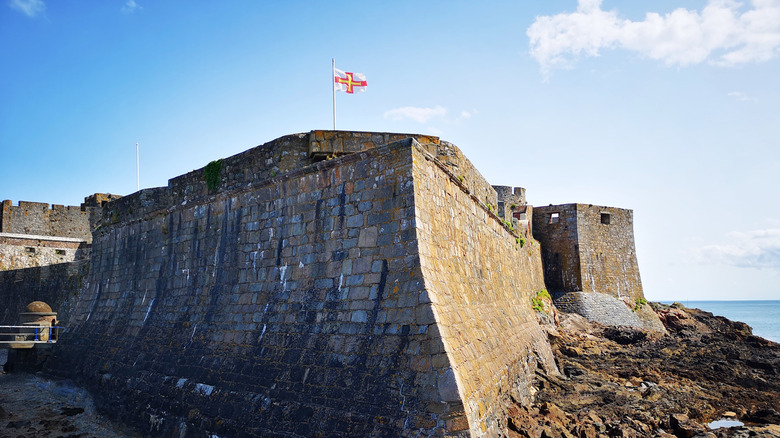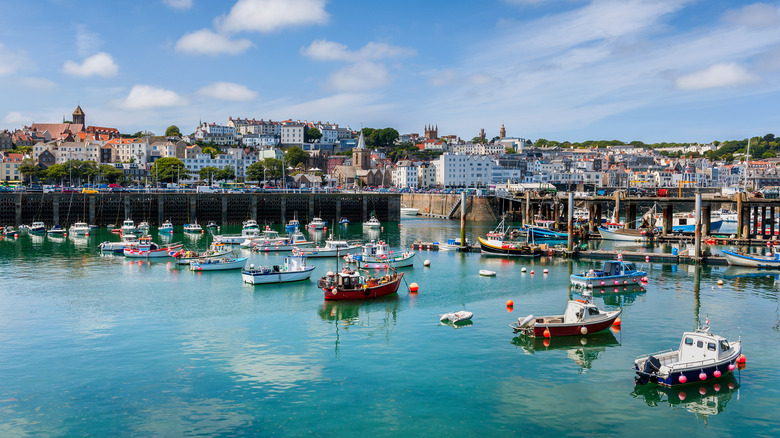This History-Rich Island Near The UK Has The Look Of A Caribbean Paradise
Guernsey is an island where history and beauty meet like the very sea and sand it's surrounded by. This British Isle (independent of the United Kingdom) is located in the English Channel, just off the coast of Normandy, France. Guernsey could easily be mistaken for a Caribbean paradise with its turquoise waters, stunning cliffsides, and lush, green landscape.
As with any Caribbean vacation, in Guernsey, you're never far from a tranquil beach or a charming port. For those seeking some crowd-free beach vacation time with a touch of wild beauty, check out Bec du Nez, Marble Bay, Port Soif, La Gouffre, and Fisherman's Landing at Saints Bay. For something more bustling, check out beaches like Cobo, L'Eree, and Vazon — the cleanest in the U.K.! These shores contain but a slice of the island's stunning 2.5 billion-year-old geological history — you'll be surrounded by granite and metamorphic rocks rich in feldspar, giving them a sparkling pink shine.
Unlike most island paradises, which can sometimes get too hot for pleasure, Guernsey enjoys a consistently temperate climate with mild winters and summers. The average temperature peaks around 62 degrees in August and dips to about 42 in February. The island maintains a humidity level of around 80%, a moderate UV index of 4, and experiences a balanced mix of rainfall and dry periods throughout the year. But Guernsey's appeal goes far beyond its shorelines and fantastic weather; what we've explored barely scratches the surface, as its unique history is what truly sets it apart.
A historical portrait of Guernsey
Guernsey's history dates back to its initial rule by William, Duke of Normandy, in 1066. By 1204, it fell under King Philippe II of France's occupation, sparking ongoing conflict over the Channel Islands between France and England. Ultimately, the island was returned to England's King Henry III. However, tumultuous times persisted — Guernsey became known as a pirates' haven, where they famously used lamplight tricks to lure ships for looting. Trouble and sorrow lingered on its history, notably through the Guernsey Martyrs in 1556, where three women faced brutal persecution for their Protestant beliefs. Today, a memorial in their honor stands in St. Peter Port, accessible by ascending the Tower Hill steps to find it on the west wall, a solemn reminder of the island's dark history.
But it wasn't all terrible; Guernsey was a muse for some of the world's most famous artists, with Renoir capturing its beauty through paintings like "Moulin Huet Bay" and Victor Hugo penning "Les Misérables" among other works while in exile on the island. Hugo's residence and gardens, the Hauteville House, is now the honorary consul to the French embassy and a museum that welcomes visitors.
Nevertheless, Guernsey is most known for its time under German rule. Termed "Hitler's Island Madness," Guernsey transformed into the most heavily fortified stronghold in the world, embodying Hitler's dream of an invincible Atlantic wall. Today, landmarks like the 800-year-old Castle Cornet and German-built museums provide a tangible link to this tumultuous past.
Tips for your visit
After all the historical and beachside exploration, Guernsey's cuisine is a must-try. The island's dairy products, like its rich, creamy milk and butter from local Guernsey cows (yes, it's a cow breed of its own!), are delectable. Traditional dishes such as the Guernsey bean jar, a stew with beans, vegetables, and ormer (a local shellfish) can be widely found. However, the most famous dish is Guernsey gâche (pronounced gosh), a sweet bread with dried fruits served with tea and butter.
Visiting Guernsey is an exciting adventure into its living history and natural beauty. The island has welcomed travelers since the Victorian era, with its first tourist guide published in 1834. However, then came the tragic sinking of the SS Stella in 1899 near Les Casquets, 20 miles northeast of Guernsey, claiming 105 lives. Thankfully, there are other ways to travel to Guernsey today besides a twin-screw steamer. You can fly from the U.K. and select European destinations or take a ferry from Poole (3 hours) and Portsmouth (6 hours).
Accommodations in Guernsey range from boutique (La Fregate) to luxury (Old Government House) and numerous family-friendly Airbnbs. Glamping, camping, and yurts at campsites like La Bailloterie offer impeccable island and nature views. But one thing is sure: consider May to September for the best weather when planning your visit. Whether you're a history buff, beach paradise lover, or an off-beat foodie, Guernsey invites you to discover its many layers; just don't go following any lamplight tricks!


